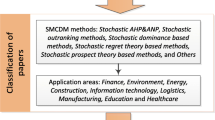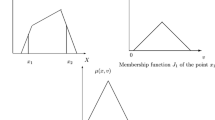Abstract
As an important area of multiple criteria decision making, stochastic multiple criteria decision making (SMCDM) with criteria 2-tuple aspirations comes to the fore because of its wide applications. The criterion 2-tuple aspiration is the criterion aspiration with a pair of values, including target value and probability level. That is, the decision maker provides not only the target value which the criteria values should meet, but also the probability level where the criteria values meet the target value. However, 2-tuple aspirations of criteria are not considered in existing SMCDM methods. In this paper, with respect to the SMCDM problem with criteria 2-tuple aspirations, a novel decision analysis method is proposed. To begin with, the definition of 2-tuple aspiration and its three types of expression are outlined. Then, the satisfaction degree functions are constructed so as to calculate the satisfaction degrees of alternatives associated with criteria 2-tuple aspirations. In order to rank alternatives or to select the most desirable alternative, two aspects, the satisfaction degrees of alternatives associated with criteria 2-tuple aspirations and the expected values of alternatives, are to be considered. Further, according to overall satisfaction degrees and overall expected values, based on TOPSIS method, the relative closeness of alternatives is calculated to obtain the ranking results. The proposed method aims to provide an effective tool for solving SMCDM problem with criteria 2-tuple aspirations. Finally, an example is given to illustrate the feasibility and validity of the proposed method.





Similar content being viewed by others
References
Atanassov K, Mavrov D, Atanassova V (2014) Intercriteria decision making: a new approach for multicriteria decision making, based on index matrices and Intuitionistic fuzzy sets. Issues Intuit Fuzzy Sets Gener Nets 11:1–8
Atanassov K, Atanassova V, Gluhchev G (2015) InterCriteria analysis: ideas and problems. Notes Intuit Fuzzy Sets 21(1):81–88
Behzadian M, Khanmohammadi Otaghsara S, Yazdani M, Ignatius J (2012) A state-of the-art survey of TOPSIS applications. Expert Syst Appl 39:13051–13069
Bi WJ, Zhang L (2012) Target oriented multi-attribute group decision making approach and application in hydroelectric project evaluation. Syst Eng Procedia 5:454–460
Bordley RF, Kirkwood CW (2004) Multiattribute preference analysis with performance targets. Oper Res 52:823–835
Chen P, Hou CZ, Feng Y (2008) Stochastic mathematics. National Defence of Industry Press, Beijing
Fan ZP, Liu Y, Feng B (2010) A method for stochastic multiple criteria decision making based on pairwise comparisons of alternatives with random evaluations. Eur J Oper Res 207:906–915
Fan ZP, Zhang X, Liu Y, Zhang Y (2013) A method for stochastic multiple attribute decision making based on concepts of ideal and anti-ideal points. Appl Math Comput 219:11438–11450
Farquhar PH (1984) Utility assessment methods. Manag Sci 30:1283–1300
Herrera F, Herrera-Viedma E (1996) A model of consensus in group decision making under linguistic assessments. Fuzzy Sets Syst 78:73–87
Hu JH, Yang L (2011) Dynamic stochastic multi-criteria decision making method based on cumulative prospect theory and set pair analysis. Eng Risk Manag 1:432–439
Huynh VN, Nakamori Y, Ryoke M, Ho TB (2007) Decision making under uncertainty with fuzzy targets. Fuzzy Optim Decis Mak 6:255–278
Hwang CL, Lai YJ, Liu TY (1993) A new approach for multiple objective decision making. Comput Oper Res 20:889–899
Jiang YP, Liang HM, Sun MH (2015) A method for discrete stochastic MADM problems based on the ideal and nadir solutions. Comput Ind Eng 87:114–125
Jiang YP, Liang X, Liang HM, Yang NM (2018) Multiple criteria decision making with interval stochastic variables: a method based on interval stochastic dominance. Eur J Oper Res 271:632–643
Klubeck M (2011) Metrics: how to improve key business results. Apress, NewYork
Kuo MS (2011) Optimal location selection for an international distribution center by using a new hybrid method. Expert Syst Appl 38:7208–7221
Kuo MS, Liang GS (2011) A novel hybrid decision-making model for selecting locations in a fuzzy environment. Math Comput Model 54:88–104
Lahdelma R, Salminen P (2001) SMAA-2: stochastic multicriteria acceptability analysis for group decision making. Oper Res 49:444–454
Liang X, Jiang YP, Liu PD (2017) Stochastic multiple-criteria decision making with 2-tuple aspirations: a method based on disappointment stochastic dominance. Int Trans Oper Res 25:913–940
Liao HC, Jiang LS, Xu ZS et al (2017) A linear programming method for multiple criteria decision making with probabilistic linguistic information. Inf Sci 415–416:341–355
Liu PD, Qi X (2014) Some generalized dependent aggregation operators with 2-dimension linguistic information and their application to group decision making. J Intell Fuzzy Syst 27:1761–1773
Lu CS (2003) Market segment evaluation and international distribution centers. Transp Res E Logist Transp Rev 39:49–60
Mousavi SM, Jolai F, Tavakkoli-Moghaddam R (2013) A fuzzy stochastic multi-attribute group decision-making approach for selection problems. Group Decis Negot 22:207–233
Nowak M (2006) INSDECM—an interactive procedure for stochastic multicriteria decision problems. Eur J Oper Res 175:1413–1430
Nowak M (2007) Aspiration level approach in stochastic MCDM problems. Eur J Oper Res 177:1626–1640
Rodriguez RM, Martinez L, Herrera F (2012) Hesitant fuzzy linguistic term sets for decision making. IEEE Press, New York
Sengupta A, Pal TK (2000) On comparing interval numbers. Eur J Oper Res 127:28–43
Sheng J, Xie SQ, Pan CY (2001) Probability and mathematical statistics. Higher Education Press, Beijing
Tan CQ, Ip WH, Chen XH (2014) Stochastic multiple criteria decision making with aspiration level based on prospect stochastic dominance. Knowl Based Syst 70:231–241
Wei GW, Lu M (2018) Pythagorean fuzzy power aggregation operators in multiple attribute decision making. Int J Intell Syst 33:169–186
Xu YJ, Cabrerizo FJ, Herrera-Viedma E (2017) A consensus model for hesitant fuzzy preference relations and its application in water allocation management. Appl Soft Comput 58:265–284
Yager RR (2014) Stochastic Dominance for measure based uncertain decision making. Int J Intell Syst 29:881–905
Yager RR, Alajlan N (2014) Probability weighted means as surrogates for stochastic dominance in decision making. Knowl Based Syst 66:92–98
Yan HB, Huynh VN, Nakamori Y (2011) A probabilistic model for linguistic multi-expert decision making involving semantic overlapping. Expert Syst Appl 38:8901–8912
Yan HB, Huynh VN, Ma TJ, Nakamori Y (2013) Non-additive multi-attribute fuzzy target-oriented decision analysis. Inf Sci 240:21–44
Ye YC, Yao N, Wang QZ, Wang QH (2015) A method of ranking interval numbers based on degrees for multiple attribute decision making. J Intell Fuzzy Syst 30:211–221
Yue ZL (2011) An extended TOPSIS for determining weights of decision makers with interval numbers. Knowl Based Syst 24:146–153
Zaras K (2001) Rough approximation of a preference relation by a multi-attribute stochastic dominance for determinist and stochastic evaluation problems. Eur J Oper Res 130:305–314
Zaras K (2004) Rough approximation of a preference relation by a multi-attribute dominance for deterministic, stochastic and fuzzy decision problems. Eur J Oper Res 159:196–206
Zhang Y, Fan ZP, Liu Y (2010) A method based on stochastic dominance degrees for stochastic multiple criteria decision making. Comput Ind Eng 58:544–552
Funding
This study was funded by National Natural Science Foundation of China (NSFC, Project Nos. 71571040, 71801142, 71871048, 71402084), Humanities and Social Sciences Research Project of Ministry of Education of China (No. 17YJC630077) and Project of Shandong Province Higher Educational Science and Technology Program (No. J17KA189).
Author information
Authors and Affiliations
Corresponding author
Ethics declarations
Conflict of interest
Authors declare that they have no conflict of interest.
Ethical approval
This article does not contain any studies with human participants or animals performed by any of the authors.
Additional information
Communicated by V. Loia.
Publisher's Note
Springer Nature remains neutral with regard to jurisdictional claims in published maps and institutional affiliations.
Rights and permissions
About this article
Cite this article
Jiang, Y., Liang, X., Li, M. et al. Stochastic multiple criteria decision making with criteria 2-tuple aspirations. Soft Comput 23, 11167–11180 (2019). https://doi.org/10.1007/s00500-018-3667-y
Published:
Issue Date:
DOI: https://doi.org/10.1007/s00500-018-3667-y




